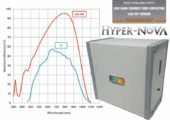Chroma describes how pure, or monochromatic, a color is compared to a white surface with the same illumination. For example, if a white surface is illuminated with 0.1W m-2 nm-1, the irradiance spectrum will also show 0.1W m-2 nm-1 at all visible wavelengths (400-700nm). When a red surface is illuminated by the same source, the spectrum will show 0.1W m-2 nm-1 only in the red region (~620-700 nm).
Chroma is similar to purity, so much so that the terms are often interchangeable. The difference is that chroma involves a constant amount of light hitting a surface, while purity involves a constant amount of light being transmitted or reflected from a surface. In the SpectraWiz software, the CIELAB graph calculates chroma.





